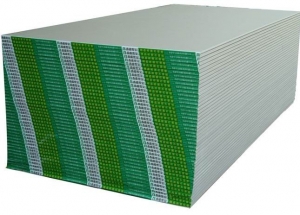Home >Products >Gypsum Board > Regular Gypsum board
Regular Gypsum boardEnquiry Now!
Product: Regular Gypsum board
Gypsum board is the generic name for a family of panel-type products consisting of a noncombustible core, primarily of gypsum, with a paper surfacing on the face, back, and long edges.
Gypsum board is often called drywall, wallboard, or plasterboard and differs from products such as plywood, hardboard, and fiberboard, because of its noncombustible core. It is designed to provide a monolithic surface when joints and fastener heads are covered with a joint treatment system.
Gypsum is a mineral found in sedimentary rock formations in a crystalline form known as calcium sulfate dehydrate. One hundred pounds of gypsum rock contains approximately 21 pounds (or 10 quarts) of chemically combined water. Gypsum rock is mined or quarried and then crushed. The crushed rock is then ground into a fine powder and heated to about 350 degreesF, driving off three fourths of the chemically combined water in a process called calcining. The calcined gypsum (or hemihydrate) is then used as the base for gypsum plaster, gypsum board and other gypsum products.
To produce gypsum board, the calcined gypsum is mixed with water and additives to form a slurry which is fed between continuous layers of paper on a board machine. As the board moves down a conveyer line, the calcium sulfate recrystallizes or rehydrates, reverting to its original rock state. The paper becomes chemically and mechanically bonded to the core. The board is then cut to length and conveyed through dryers to remove any free moisture.
ADVANTAGES OF GYPSUM BOARD CONSTRUCTION
Gypsum board walls and ceilings have a number of outstanding advantages:
• Fire Resistive
• Sound Attenuation
• Durability
• Economy
• Versatility
Fire Resistive
Gypsum board is an excellent fire resistive material. It is the most commonly used interior finish where fire resistance classifications are required. Its noncombustible core contains chemically combined water which, under high heat, is slowly released as steam, effectively retarding heat transfer. Even after complete calcination, when all the water has been released, it continues to act as a heat insulating barrier. In addition, tests conducted in accordance with ASTM E 84 show that gypsum board has a low flame spread index and smoke density index. When installed in combination with other materials it serves to effectively protect building elements from fire for prescribed time periods.
For information about the use of gypsum board in fire-resistant construction systems consult GA-600, Fire Resistance Design Manual.
Sound Attenuation
Control of unwanted sound that might be transmitted to adjoining rooms is a key consideration in the design or renovation stage of a building or residence, taking into account the environment described for the particular activity of the occupants. Gypsum board wall and ceiling systems effectively help control sound transmission. Suggested systems for sound attenuation and sound control are described and illustrated in GA-600, Fire Resistance Design Manual along with recommended procedures to obtain sound control.
Durability
Gypsum board is used to construct strong high quality walls and ceilings with excellent dimensional stability and durability. The surfaces are easily decorated and refinished.
Economy
Gypsum board is readily available and easy to apply. It is an inexpensive wall surfacing material offering a fire-resistant interior finish. Both regular and pre-decorated gypsum board may be installed at relatively low cost. When pre-decorated board is used, further decoration is unnecessary.
Versatility
Gypsum board satisfies a wide range of architectural requirements for design. Ease of application, performance, availability, ease of repair, and its adaptability to all forms of decoration combine to make gypsum board unmatched by any other surfacing product.
We profide following size of gypsum board:
Regular Gypsum board
Board Lenght, mm | Board Width, mm | Board Thikness, mm |
1830 | 1220 | 7,0 / 8,0 / 9,0 |
2400 | 1200 | 7,0 / 8,0 / 9,0 |
2440 | 1220 | 9,5 / 12,0 / 12,7 |
3000 | 1200 | 9,5 / 12,0 / 12,7 |
3050 | 1200 | 9,5 / 12,0 / 12,7 |
3660 | 1220 | 15,0 / 15,9 |

